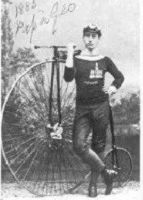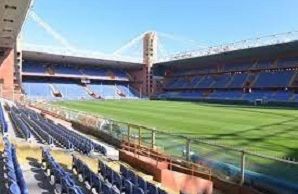George (Geo) Davidson

Much like Association football itself Genoa Cricket and Football Club, as it is still officially called to this day, was an English invention that was given legs by a Scot. Indeed, it would be no exaggeration to suggest not calcio itself but professional football in Italy owes its origins to that same not Italian-Scot but Scottish-Italian. His name is George (Geo) Davidson, born in Letham by Forfar in Angus in 1865. In fact to be precise he was born there in The Square.
However, Geo Davidson was himself not a footballer. His forte in his youth had been that other Italian sporting passion, cycling. At twenty-one in 1886 he became Italy's second ever road cycle-racing champion. The penny-farthing, yes, penny-farthing, on which he achieved the title hangs today in the Genoa F.C. museum. But it does not mean he did not know his round-ball game and potentially from early on, perhaps even those involved. Letham's The Square was in 1866, so the year after his, to be the birthplace too of the great Ned Doig, whose father was the local shoemaker so known by everyone and whose mother was a local girl.
The Davidson family had arrived in Genoa by a somewhat circuitous route. Isabella Gray, Geo's mother, was also a Letham girl, so would have known the Doigs, and his father, also George, was the son of weavers from Fife. But by the time of the wee man's birth the couple had been married in France, in Brittany, then the centre of the French linen industry, and back home, George was recorded as a linen-dresser. Moreover, after a stay in Arbroath, George Snr recorded as a Linen Factory Manager, it was probably that same material, which by 1873, Geo aged seven, was to take them all, not yet to Genoa but to nearby Novi Ligure, a centre of the Italian textile trade.
However times were changing. The days of sail and therefore a guaranteed demand for linen sail-cloth were coming to the end, causing the family not to return home, where the same decline was also being felt, but move to the nearest city. Genoa was booming post the opening of the Suez Canal in 1869 and there George Snr. probably went into selling sealing products and then ship-provisioning, not least British ships. Certainly that was to become Geo's original business.

Thus it was that in 1897 with Genoa requiring to move from its first ground, incidentally one owned by two expatriate Scots, Geo Davidson first became involved with the round-ball game. It is said he was instrumental in a track belonging to his cycle-club becoming the Red-Blue's new football-field, after which he stayed on, joining the Board and becoming increasingly involved and powerful. The reasons were two-fold. The first was his proven general and sports business-acumen. Cycling was already professional. The second was his Britishness. Football was still the British game. After a period when some Italian clubs attempted to limit players for all to being Italian, Genoa began to bring in players from the Home Countries and even hired a British manager. And clearly both manager and players had first to be found by someone bi-lingual, a regular-traveller-to-Britain and perhaps with connections at home, perhaps Doig himself, Davidson being the obvious candidate.

However, whilst a manager might be paid by what was officially still an amateur club, the players also needed to be rewarded and financially. In Britain they were professional. In Italy they could only be shamateur, paid under the table. Indeed Genoa was soon accused of precisely such practices, by which time Davidson had in 1913 stepped up as Club President. And in place he remained un-cowed, not least because there were bills to be paid, the club having in 1911 moved once more, to a new, larger stadium at Marassi, where it remains today.
In fact Davidson's seven years at the Genoa helm meant that when he stepped back in 1920 full professionalism had been almost forced through. Juventus in 1923 was the first to be openly so. However, even by the first year of the decade he had begun a return to his first love. In 1915 he had also become President of the Italian Cycling Union, remaining in place until 1927. He was a cycling judge at the 1924 Olympics in Paris. And having moved with his family along the Ligurian coast from Genoa to Rapallo, there he became the driving-force behind the town's cycling club and the creation of today's iconic Milan-Rapallo race. It was first run in 1946, a decade before his death, aged ninety-one, also in Rapallo, following which he was buried in the family tomb. It can be found in Genoa's Staglieno Cemetery.
Birth Locator:
1865 - The Square, Letham, Angus
Residence Locator(s):
1871 - 72, Keptie St., Arbroath, Angus
1873 - Novi Ligure, Piedmont, Italy
Grave Locator:
Staglieno Cemetery, Genoa, Italy
Other Sources:
Back to the Italian Trail or the SFHG Home page